Where and how does rice grow, and is it possible to grow it at home?
When eating rice for breakfast, lunch or dinner, rarely does anyone think about where this crop grows and what unusual conditions are needed to get the harvest. From the article you will learn where rice grows, what it looks like and how to grow it at home.
Features of culture
Rice is an annual hydrophyte crop. Its cultivation requires flooded soil, irrigation or high rainfall. He loves the sun; cloudy weather interferes with development. The optimal temperature for rice growth is +25…+28°C. When the temperature drops to 15°C, its development slows down. And if the temperature drops to 12°C, this will lead to empty grains.
Nutrition provision affects cereal yield. Nitrogen deficiency leads to slower growth and a decrease in yield, and its excess leads to an increase in vegetative mass, a decrease in grain weight and fungal damage.
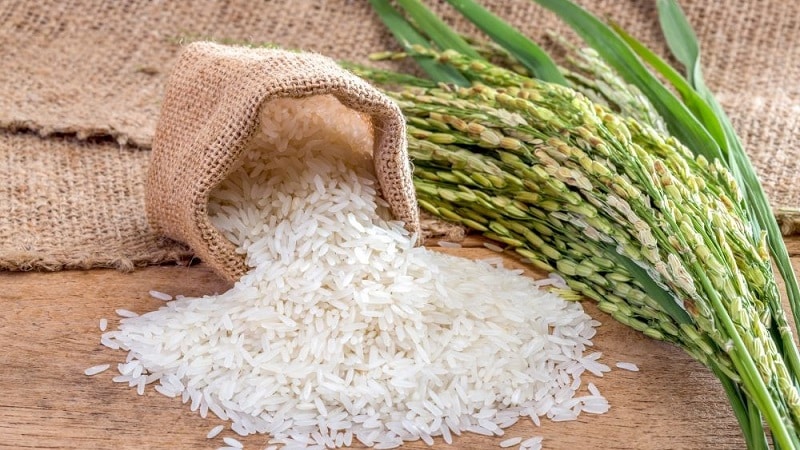
Botanical description
Rice has a fibrous root system that penetrates to a depth of 20-30 cm and consists of a main and adventitious root. A distinctive feature of its roots is the presence of tissue with air-conducting cavities (aerenchyma). Thanks to it, the root system is saturated with oxygen coming from the stems and leaves.
The stem is straw up to 1.5-2 m high.
Leaves are long and narrow with a well-defined vein. Leaf length is about 50 cm, width is 1 cm.
Inflorescence - panicle, reaching up to 30 cm in length. The fruit is a grain located in the flower scales.
Rice is a self-pollinating plant. Cross pollination rarely occurs.
Rice in crop rotation
Rice is cultivated using special five- to nine-field crop rotations.. To create a favorable environment for re-seeding, take breaks. At this time, the fields are freed from flooding and upland plants are planted on them - alfalfa, sweet clover, clover - or the areas are left fallow.
The main purpose of the steam unit — carrying out reclamation and repair work. At this time, green manure plants are grown to improve the structure of the soil, enrich it with nutrients and inhibit the growth of weeds.
The best plants to grow fallow:
- Vika;
- rape;
- peas;
- rank;
- mixture of legumes and cereals;
- buckwheat.
After a fallow field, rice is sown for two years, and after grass and legumes, for three.
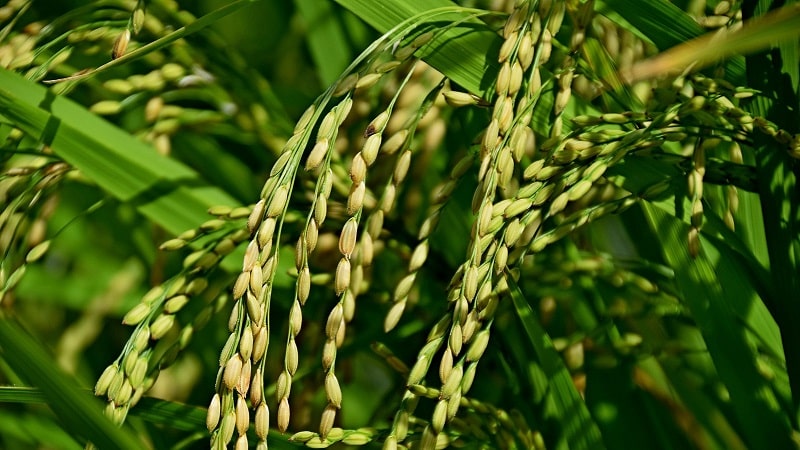
The use of pure fallow in rice crop rotation has not proven effective. In this case, there is a loss of such an important nutrient as nitrogen, because after a new flood it goes into the atmosphere, being reduced to free molecular nitrogen from the nitrate form.
How and where does rice grow?
Rice is common in China, Indonesia, Vietnam, India and South America. The climate suitable for its cultivation is tropical, but it is also found in the subtropics. In Russia, the culture grows in the Krasnodar and Primorsky territories, Astrakhan and Rostov regions, as well as in the Chechen Republic and Kalmykia.
There are several growing methods:
- Dryland rice farming used in areas with sparse rainfall, warm summers and low-lying marshy areas.
- Irrigated rice farming - the most popular method.For this purpose, the territories are specially flooded - dug ditches are filled with water, which is drained half a month before harvesting so that the soil dries out a little.
- Estuary rice growing - an ineffective method used only in some areas in the south and east of Asia. River bays and areas with floods are used to grow the crop.
Growing in water
Even though the rice grows well in normal soil, growing in water increases yield. Why does rice grow better in water? This is due to the fact that weeds cannot grow in such conditions, and more space is left for the development of beneficial grains. The plant also receives nutrition from water.
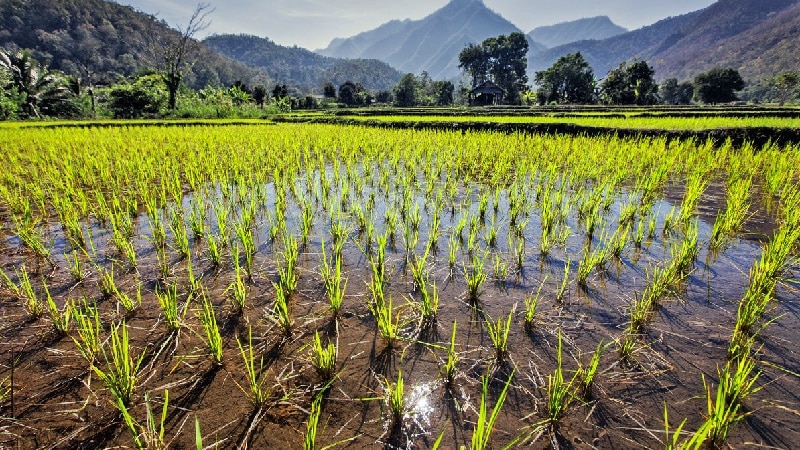
Features of cultivation depending on the type of rice
Rice is divided into three types based on the shape and size of the grain.:
- long grain;
- medium grain;
- round grain.
The technology for growing different species is the same.
When growing rice, seedlings are sown first.. After 30-50 days it is planted in soil filled with water. After the grains are ripe, the water is drained and the plant is allowed to dry.
The crop is then harvested and further dried, after which the grains are threshed. Then the husks and, if necessary, the top layer are removed from them to obtain white rice.
Agricultural technology
To get a big harvest comply with cultivation technology:
- Crop rotation. When growing rice, its conditions cannot be neglected.
- Tillage. The method depends on the type of soil. For chernozem, plowing with moldboard plows to a depth of 20 cm is suitable, for solonchaks - non-moldboard plowing to the same depth. Alkaline soils are cultivated to a depth of 15 cm with shallow plowing. If marsh plants grow, plow at a distance greater than the depth of the roots. Then the field is leveled and, if necessary, loosened.
- Sowing rice. Basically, the ordinary sowing method is used. The seed sowing rate is 5.5-7 million viable grains per 1 ha, planting depth is 1.5-2 cm.
- Fertilizers. Rice needs nitrogen, potassium and phosphorus fertilizers. Per ton of rice grain requires 24.2 kg of nitrogen, 12.4 kg of phosphorus, 30 kg of potassium. Organic fertilizers are applied during land reclamation or fallow phases.
- Crop care includes fertilizing, spraying, desiccation, senication, disease and pest control.
- Harvest. They are harvested using a separate method and direct combining with pre-treatment with desiccants.
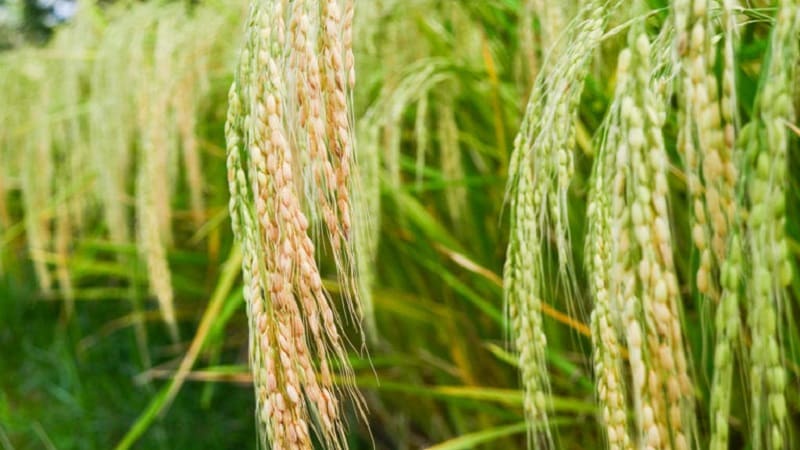
Where in the world are rice plantations grown?
Although Asia is considered the birthplace of this cereal, it now grows all over the world.. The leaders in rice production are China and India, Indonesia, Bangladesh, Vietnam, Thailand and Myanmar.
Grown in different countries various varieties:
- long grain — Asia, Australia, America;
- round grain - China, Russia, Ukraine, Italy;
- medium grain - Italy, Spain, North America, Australia;
- jasmine — Thailand;
- basmati - northern India and Pakistan;
- black — China;
- red - France;
- wild - USA, Canada.
In China
In China, rice is grown in fields flooded with water.. First, the seeds are sown in a special greenhouse in the soil, which is a mixture of mud and water. The most resistant plants survive in such soil. When the seedlings grow to 10 cm, the sprouts are thrown into water. When their length reaches 50 cm, flowering will begin.
At this time, grains are formed. After harvesting, the rice is laid out directly on the road, allowing it to dry, then taken to the warehouse. Under optimal conditions, rice can be stored for a year; when packaged, it can be stored for up to 3 years.
In Russia
In Russia, rice begins to be grown in May. First, the soil is thoroughly watered.When the sprouts reach a height of 15-20 cm, the fields are filled with water. The tops of the sprouts should stick out above the water. The fields are drained 15-20 days before harvesting.
In India
In India, rice is pre-sprouted for 1-2 months.. Sprouted grains are placed in soil with water. Water is drained from rice fields before harvesting or weeding. Harvest before the plant leaves turn yellow. One field in India is harvested 2-4 times a year.
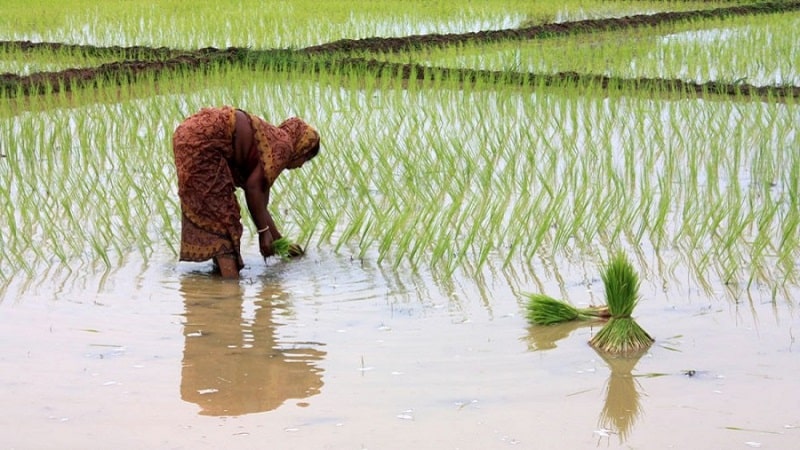
In Thailand
Throw grains into the prepared soil and wait for sprouts to appear.. Next, the sprouts are collected and evenly planted. Cereals are grown for 30 days. During harvest, the rice is cut and the grain is knocked into a separate container. Then it is cleaned of debris, polished or steamed.
In Italy
First, the soil is prepared, the checks are filled with water, then the grains are sown from tractors. After a week, the fields are drained to allow the grains to take root. Then they fill it again to 10 cm and maintain this regime. Harvesting begins when the stems reach a height of 1.5 m. The harvested grain is dried, packaged and stored.
In Japan
Humus is spread over the field, then it is flooded and plowed. This swamp becomes a nursery for rice seeds that are sown there. When the shoots grow to 20 cm, they are transplanted by hand into the field. The soil between the rows of plants is weeded, loosened and then mulched. Rice straw is used as mulch. It helps retain water in the field, which remains flooded for 3 months. The harvest is harvested manually or using combines.
Productivity
In the leading rice-growing countries, the crop is harvested several times in year.
Reference. The average rice yield is about 60 c/ha. Maximum yield - up to 150 c/ha.
Rice yield largely depends on crop rotation. Depending on what crops were grown in front of him, more or less grains were obtained. If rice was planted after the fallow crops were grown, its yield increased compared to rice crops that were not preceded by fallow crops. Productivity was higher when intermediate plants were grown as green manure.
How is rice harvested?
Before harvesting, the water is drained and the field is dried so that harvesting equipment can pass through it. Approximately 15 days after the water has left, you can begin harvesting.

Harvesting begins when the grain is ripe. This can be understood by the color of the grain shells.
Rice is harvested using a two-phase method, because the grains do not ripen at the same time. When the moisture content of the grains in the forks is 15%, the rice is threshed. For high yields, double threshing is required to reduce grain loss and damage.
To accelerate ripening, senication is performed, and to dry the stems and enable single-phase harvesting - desiccation.
The single-phase method is used in case of sparse stems or early frosts.
Immediately after harvesting the grains are processed - dried and passed through cleaning machines.
Is it possible to grow rice at home?
Experienced farmers grow rice on their plots and even get a harvest.
Not all regions will be able to grow this crop, since for it special conditions are needed:
- daytime temperature for 3-6 months +22...+25°C, night temperature - not lower than +15°C;
- the area should be warmed by the sun;
- the ability to make a flooded bed;
- presence of an irrigation system.
To grow rice in your garden, you should knowhow to properly care for it.
How to do it
Rice loves warmth and moisture. Choose a suitable place - it should be sunny. Planting should be done in late spring, when temperatures are already consistently high. Some farmers plant grains directly into the ground, but the seedling method is more effective.
Prepare beds or boxes. Remove weeds, dig up and water the garden bed. The soil should always be moist.

Prepare planting material - soak it for 12-36 hours in water at room temperature. Make holes or furrows in the garden bed, fill them with water and distribute the sprouted grains into them. Fill the top with soil and water again.
When the seedlings grow to 2 cm, fill the bed with water to 2.5 cm.
If the sprouts are sitting too close to each other, thin out the planting. The distance between seedlings should be 30 cm.
Reference. When using the seedling method, sprouts that have grown to 2 cm are planted in the ground.
Ripening of grains takes 3-4 months. Before harvesting, you need to let the water dry or pump it out. After two weeks, the cereal can be harvested when the grain dries and turns yellow. The stems are cut directly under the ears and stored in a dry, ventilated room for 2-4 weeks so that the grain is completely dry. Then the grains are removed and dried again in the oven. The rice is cooled and peeled. The result is rice grown with your own hands.
Conclusion
Growing rice is a labor-intensive process that requires technical equipment and deep knowledge. To obtain a tasty and healthy cereal, specially created conditions are required. It can be grown in your home plot with a lot of effort.